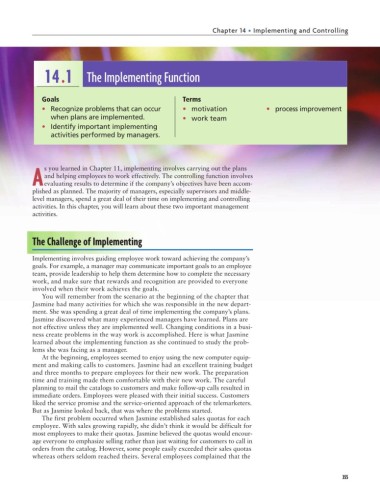Page 368 - Business Principles and Management
P. 368
Chapter 14 • Implementing and Controlling
14.1 The Implementing Function
Goals Terms
• Recognize problems that can occur • motivation • process improvement
when plans are implemented. • work team
• Identify important implementing
activities performed by managers.
s you learned in Chapter 11, implementing involves carrying out the plans
and helping employees to work effectively. The controlling function involves
Aevaluating results to determine if the company’s objectives have been accom-
plished as planned. The majority of managers, especially supervisors and middle-
level managers, spend a great deal of their time on implementing and controlling
activities. In this chapter, you will learn about these two important management
activities.
The Challenge of Implementing
Implementing involves guiding employee work toward achieving the company’s
goals. For example, a manager may communicate important goals to an employee
team, provide leadership to help them determine how to complete the necessary
work, and make sure that rewards and recognition are provided to everyone
involved when their work achieves the goals.
You will remember from the scenario at the beginning of the chapter that
Jasmine had many activities for which she was responsible in the new depart-
ment. She was spending a great deal of time implementing the company’s plans.
Jasmine discovered what many experienced managers have learned. Plans are
not effective unless they are implemented well. Changing conditions in a busi-
ness create problems in the way work is accomplished. Here is what Jasmine
learned about the implementing function as she continued to study the prob-
lems she was facing as a manager.
At the beginning, employees seemed to enjoy using the new computer equip-
ment and making calls to customers. Jasmine had an excellent training budget
and three months to prepare employees for their new work. The preparation
time and training made them comfortable with their new work. The careful
planning to mail the catalogs to customers and make follow-up calls resulted in
immediate orders. Employees were pleased with their initial success. Customers
liked the service promise and the service-oriented approach of the telemarketers.
But as Jasmine looked back, that was where the problems started.
The first problem occurred when Jasmine established sales quotas for each
employee. With sales growing rapidly, she didn’t think it would be difficult for
most employees to make their quotas. Jasmine believed the quotas would encour-
age everyone to emphasize selling rather than just waiting for customers to call in
orders from the catalog. However, some people easily exceeded their sales quotas
whereas others seldom reached theirs. Several employees complained that the
355

